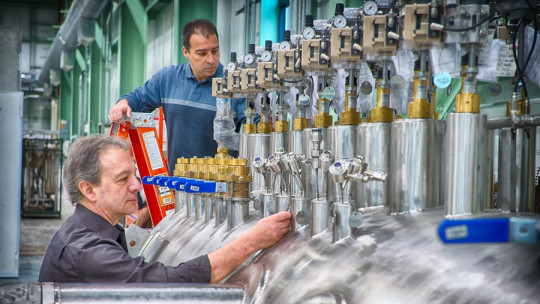In an organization, there is a constant movement of goods and services, elements that were originally raw materials acquired by the company and ultimately products sold to the public.
The process that goes from when raw materials are acquired, transformed and sold is called a company’s financial cycle, a set of actions that repeats itself perpetually and whose duration depends directly on the number of people and activities involved in it. are involved.
Below we will see in more depth the definition of the financial cycle of a company, its characteristics, periods and calculations within this concept and what its short and long term modalities are.
What is the financial cycle of a company?
The financial cycle of a company is the constant movement of goods and services that occurs within an organization so that it can continue operating When one of these cycles is completed it starts again.
This process ranges from the purchase of raw materials, through its conversion into certain finished products or services, the sale, the file until making money, which is the main objective of any company.
Thus, the financial cycle is the period of time it takes a company to carry out all its operations , this is how long it takes to perform its normal operation. By evaluating the financial cycle of an organization, one can have a vision of the operational efficiency of a company and, if it is too long, the institution itself must make efforts to shorten it as much as possible and ensure that its economic activity represents a business that be more efficient and successful.
The shorter the financial cycle, the sooner the company will be able to recover its investment On the other hand, if the financial cycle is longer, it will mean that the company will need more time to transform the raw materials it has acquired into the goods or services it offers and that allow it to make profits.
Characteristics
Business financial cycles They tell us how many days pass since the necessary materials are purchased so that the organization can manufacture or sell goods and services , collect the cash from those sales, pay your suppliers and get the cash back. This process is useful to estimate the amount of working capital that the organization will need to maintain or grow its operation, that is, to have a minimum profit and obtain economic benefit.
In the financial cycle you want to have a good investment-profit relationship, that is, you want to invest just enough to make money, without this implying the loss of sales due to not having stocks of materials or not having carried out adequate financing. That is, entrepreneurs look for the best way to obtain more profits without investing too much. Management decisions or negotiations with business partners will affect the company’s financial cycle, making it either longer or shorter.
Usually, Companies that have a short financial cycle require less cash, since there are usually fewer people involved and, therefore, fewer salaries In these cases, although there are small profit margins, growth can be achieved either by saving and investing in better machinery. On the other hand, if a company has a long financial cycle, even if it has high profit margins, it could require additional financing to be able to grow since it needs more money to move forward as there are more people involved, with little savings.
The financial cycle can be determined mathematically and simply using the following formula (considering a period of 12 months):
inventory period + accounts receivable period = financial cycle
Next we will see what the inventory period and the accounts receivable period are.
Inventory period
We can define the inventory period as the number of days that inventory remains in storage once it has been produced This can be understood with the following formula:
Inventory period = average inventory / cost of goods sold per day
Average inventory is the sum of the amount of beginning inventory at the beginning of the year or time period being measured plus the inventory at the end of the year or time period measured. This result is divided by 2. Regarding the cost of merchandise, this value is obtained by dividing the total annual cost of merchandise sold by 365 days of the year or the days of the evaluated period.
Accounts receivable period
The accounts receivable period is the duration in days to recover cash from the sale of inventory
Accounts Receivable Period = Average Accounts Receivable/Sales Per Day
The average accounts receivable is the sum of the total accounts receivable at the beginning of the year or period evaluated plus the accounts receivable at the end of that year or period, dividing the result by 2. Regarding sales per day These are determined by dividing the total sale by 365.
Financial cycle and net financial cycle
The net financial cycle or cash cycle tells us how long it takes a company to recover cash from the sale of inventory
Net financial cycle = financial cycle – accounts payable period
At the same time, The accounts payable period can be defined by the following formula :
Accounts payable period = average accounts payable / cost of merchandise sold per day
The average accounts payable is the sum of the total accounts payable at the beginning of the year or period plus the accounts payable at the end of the year or period measured, the result being divided by 2. The cost of merchandise sold per day It is determined in the same way as for the inventory period.
Short and long term
As we said, the financial cycle of a company is the time it takes to carry out its normal operation. As it is defined based on the time variable, this cycle must necessarily be classified into two: short-term or current financial cycle and long-term or non-current financial cycle.
Short term or current
The short-term or current financial cycle represents the flow of funds or their operational generation (working capital) This type of cycle lasts depending on the amount of resources required to carry out its normal operation. The elements that make up this cycle are the acquisition of raw materials, their conversion into finished products, their sale and obtaining economic profits, these phases being those that constitute current assets and current liabilities, which are part of working capital.
By working capital we refer to the investment that a company makes in current assets: cash, marketable securities, accounts receivable and inventories. The concept “current” refers to the time with which the company carries out its normal operations within the terms defined as commercial, which may be 30, 60, 90, 120 or 180 days, normally coinciding with its credit policy. and collection and with the deadlines given by its suppliers for the settlement of accounts payable.
Net working capital is defined as current assets minus current liabilities , the latter being bank loans, accounts payable and accrued taxes. A company will make profits as long as assets exceed liabilities, that is, it earns more than it has to spend and pay.
Net working capital allows us to make an approximate calculation of the company’s capacity to continue with the normal development of its activities during a specific period of time in the medium and long term, usually being looked at for the next twelve months.
The indicators provided by the short-term financial cycle are two: liquidity and solvency Liquidity represents the quality of assets that can be converted into cash immediately without significant loss of value. The solvency of a company is its ability to meet its debts and its ability to pay, that is, it is a relationship between what the company has and what it owes.
Long-term or non-current
The long-term or non-current financial cycle encompasses the fixed and lasting investments made to meet the business objectives, and the equity held in the results of the period and long-term loans as well as financing several. Permanent investments, such as real estate, machines, equipment and other long-term materials and assets, gradually participate in the short-term financial cycle through their depreciation, amortization and depletion.
The long-term financial cycle helps the short-term financial cycle by increasing working capital. The duration of the long-term financial cycle is the time it takes the company to recover all that fixed and lasting investment made. This cycle has been adopted to classify certain concepts that imply economic gains for more than one year or are greater than the normal cycle of short-term operations.
Among the elements that make up the long-term financial cycle we have non-current assets, non-current liabilities and equity and all of this is subtracted from reserves, contingencies and long-term provisions. Regarding its indicators, we have two: debt and profitability on investments or return on investment
The importance of knowing both types of financial cycles
It is of great importance to know the duration of the financial cycle in the short and long term, since it allows us to:
When talking about the financial cycle, we will always be talking about the time in which cash flows through the company, leaving and entering it That is, it is the time it takes for money to be converted back into cash after having gone through the company’s operational activities, which are within what we call the short-term financial cycle, and/or going through investment activities. or financing, which are in the long-term financial cycle.









